Sun Safety and Skin Cancer: Prevention Strategies for Young Adults
VerifiedAdded on 2023/01/19
|13
|3253
|69
Report
AI Summary
This report examines sun safety and skin cancer, focusing on young adults (25-35) in Australia. It investigates the efficacy of sun safety behaviors and strategies, including sunscreen and physical barriers, in reducing skin cancer risk. The report details a search strategy using databases like Pubmed, CINAHL, and Medline, and analyzes eight relevant peer-reviewed articles. Findings reveal that sunscreen use does not always significantly reduce skin cancer risk and that physical barriers, such as protective clothing and shade, may be more effective. The report also identifies gaps in research, such as the need for randomized control trials, and emphasizes the importance of knowledge and cancer-related information. It concludes with a quality assessment of a quantitative study and a research question about the efficacy of sunscreen utilization in reducing skin cancer risk.
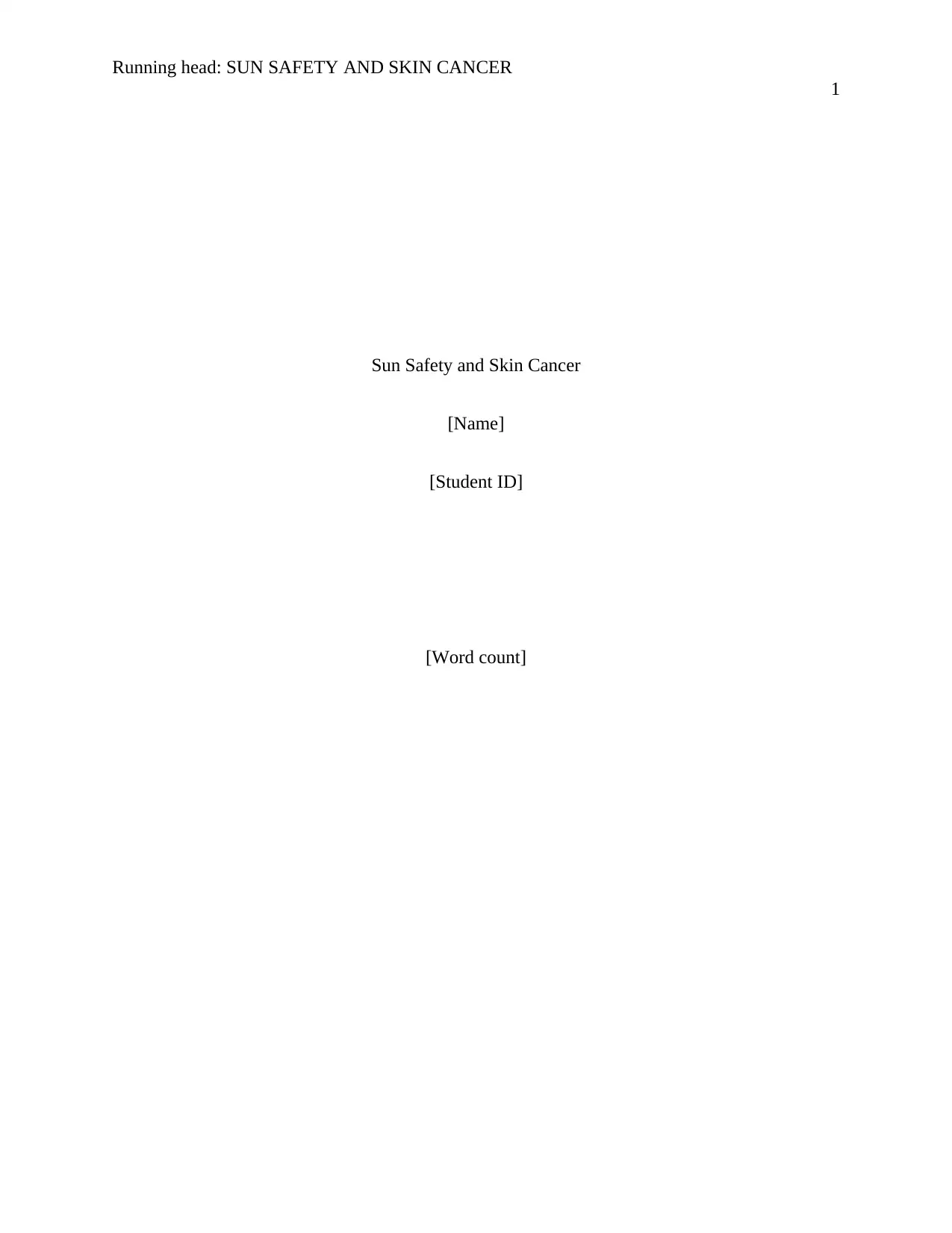
Running head: SUN SAFETY AND SKIN CANCER
1
Sun Safety and Skin Cancer
[Name]
[Student ID]
[Word count]
1
Sun Safety and Skin Cancer
[Name]
[Student ID]
[Word count]
Paraphrase This Document
Need a fresh take? Get an instant paraphrase of this document with our AI Paraphraser
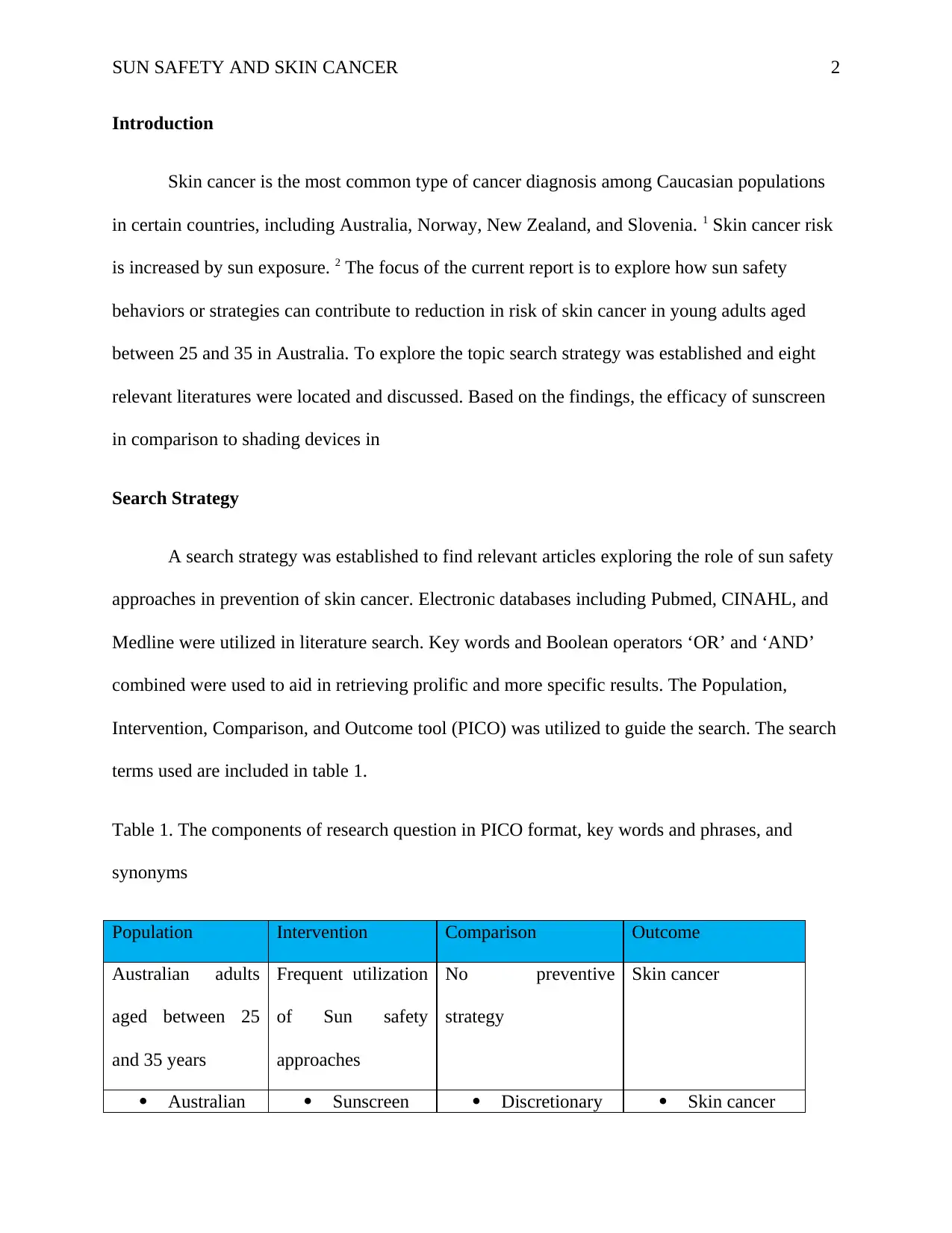
SUN SAFETY AND SKIN CANCER 2
Introduction
Skin cancer is the most common type of cancer diagnosis among Caucasian populations
in certain countries, including Australia, Norway, New Zealand, and Slovenia. 1 Skin cancer risk
is increased by sun exposure. 2 The focus of the current report is to explore how sun safety
behaviors or strategies can contribute to reduction in risk of skin cancer in young adults aged
between 25 and 35 in Australia. To explore the topic search strategy was established and eight
relevant literatures were located and discussed. Based on the findings, the efficacy of sunscreen
in comparison to shading devices in
Search Strategy
A search strategy was established to find relevant articles exploring the role of sun safety
approaches in prevention of skin cancer. Electronic databases including Pubmed, CINAHL, and
Medline were utilized in literature search. Key words and Boolean operators ‘OR’ and ‘AND’
combined were used to aid in retrieving prolific and more specific results. The Population,
Intervention, Comparison, and Outcome tool (PICO) was utilized to guide the search. The search
terms used are included in table 1.
Table 1. The components of research question in PICO format, key words and phrases, and
synonyms
Population Intervention Comparison Outcome
Australian adults
aged between 25
and 35 years
Frequent utilization
of Sun safety
approaches
No preventive
strategy
Skin cancer
Australian Sunscreen Discretionary Skin cancer
Introduction
Skin cancer is the most common type of cancer diagnosis among Caucasian populations
in certain countries, including Australia, Norway, New Zealand, and Slovenia. 1 Skin cancer risk
is increased by sun exposure. 2 The focus of the current report is to explore how sun safety
behaviors or strategies can contribute to reduction in risk of skin cancer in young adults aged
between 25 and 35 in Australia. To explore the topic search strategy was established and eight
relevant literatures were located and discussed. Based on the findings, the efficacy of sunscreen
in comparison to shading devices in
Search Strategy
A search strategy was established to find relevant articles exploring the role of sun safety
approaches in prevention of skin cancer. Electronic databases including Pubmed, CINAHL, and
Medline were utilized in literature search. Key words and Boolean operators ‘OR’ and ‘AND’
combined were used to aid in retrieving prolific and more specific results. The Population,
Intervention, Comparison, and Outcome tool (PICO) was utilized to guide the search. The search
terms used are included in table 1.
Table 1. The components of research question in PICO format, key words and phrases, and
synonyms
Population Intervention Comparison Outcome
Australian adults
aged between 25
and 35 years
Frequent utilization
of Sun safety
approaches
No preventive
strategy
Skin cancer
Australian Sunscreen Discretionary Skin cancer
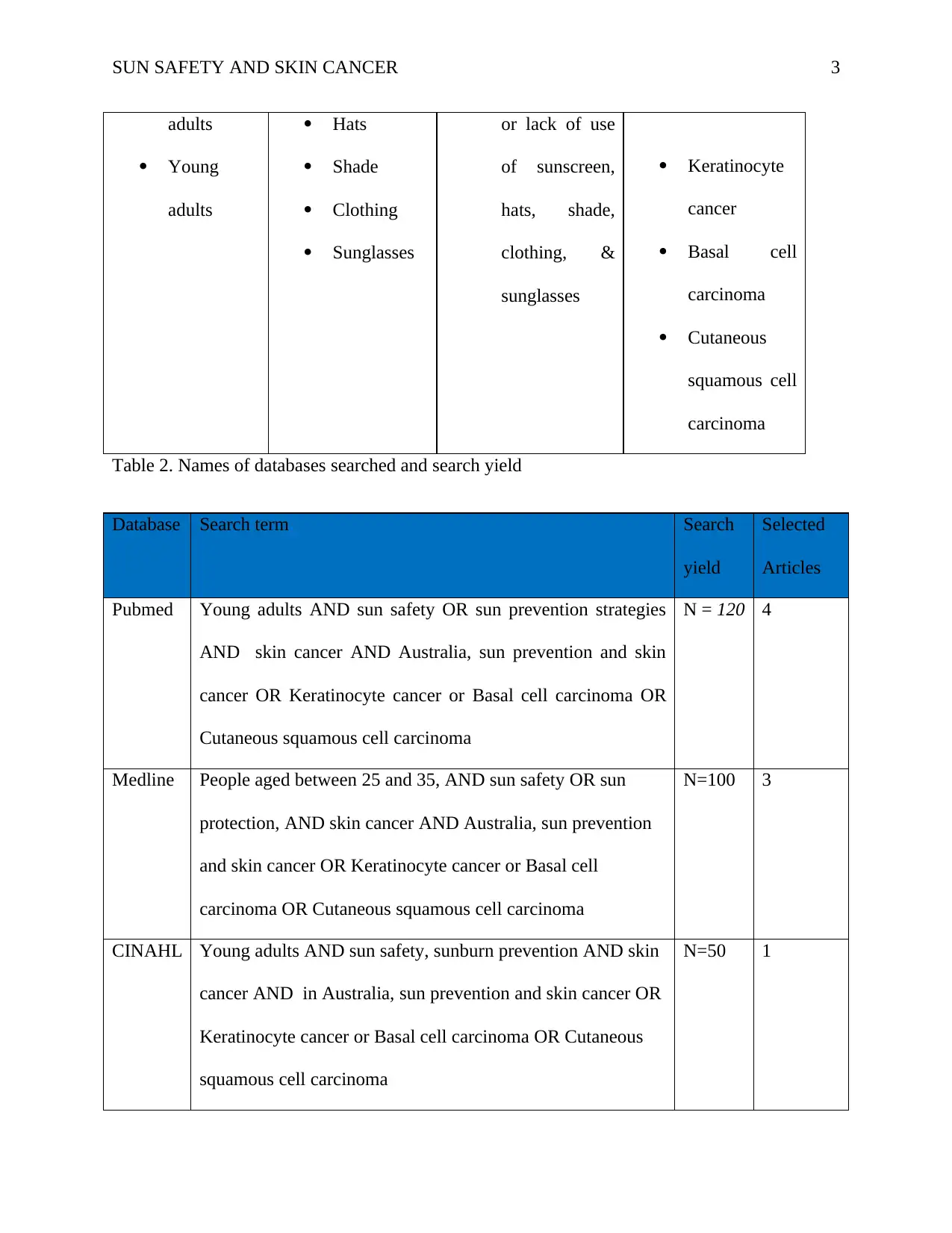
SUN SAFETY AND SKIN CANCER 3
adults
Young
adults
Hats
Shade
Clothing
Sunglasses
or lack of use
of sunscreen,
hats, shade,
clothing, &
sunglasses
Keratinocyte
cancer
Basal cell
carcinoma
Cutaneous
squamous cell
carcinoma
Table 2. Names of databases searched and search yield
Database Search term Search
yield
Selected
Articles
Pubmed Young adults AND sun safety OR sun prevention strategies
AND skin cancer AND Australia, sun prevention and skin
cancer OR Keratinocyte cancer or Basal cell carcinoma OR
Cutaneous squamous cell carcinoma
N = 120 4
Medline People aged between 25 and 35, AND sun safety OR sun
protection, AND skin cancer AND Australia, sun prevention
and skin cancer OR Keratinocyte cancer or Basal cell
carcinoma OR Cutaneous squamous cell carcinoma
N=100 3
CINAHL Young adults AND sun safety, sunburn prevention AND skin
cancer AND in Australia, sun prevention and skin cancer OR
Keratinocyte cancer or Basal cell carcinoma OR Cutaneous
squamous cell carcinoma
N=50 1
adults
Young
adults
Hats
Shade
Clothing
Sunglasses
or lack of use
of sunscreen,
hats, shade,
clothing, &
sunglasses
Keratinocyte
cancer
Basal cell
carcinoma
Cutaneous
squamous cell
carcinoma
Table 2. Names of databases searched and search yield
Database Search term Search
yield
Selected
Articles
Pubmed Young adults AND sun safety OR sun prevention strategies
AND skin cancer AND Australia, sun prevention and skin
cancer OR Keratinocyte cancer or Basal cell carcinoma OR
Cutaneous squamous cell carcinoma
N = 120 4
Medline People aged between 25 and 35, AND sun safety OR sun
protection, AND skin cancer AND Australia, sun prevention
and skin cancer OR Keratinocyte cancer or Basal cell
carcinoma OR Cutaneous squamous cell carcinoma
N=100 3
CINAHL Young adults AND sun safety, sunburn prevention AND skin
cancer AND in Australia, sun prevention and skin cancer OR
Keratinocyte cancer or Basal cell carcinoma OR Cutaneous
squamous cell carcinoma
N=50 1
⊘ This is a preview!⊘
Do you want full access?
Subscribe today to unlock all pages.

Trusted by 1+ million students worldwide
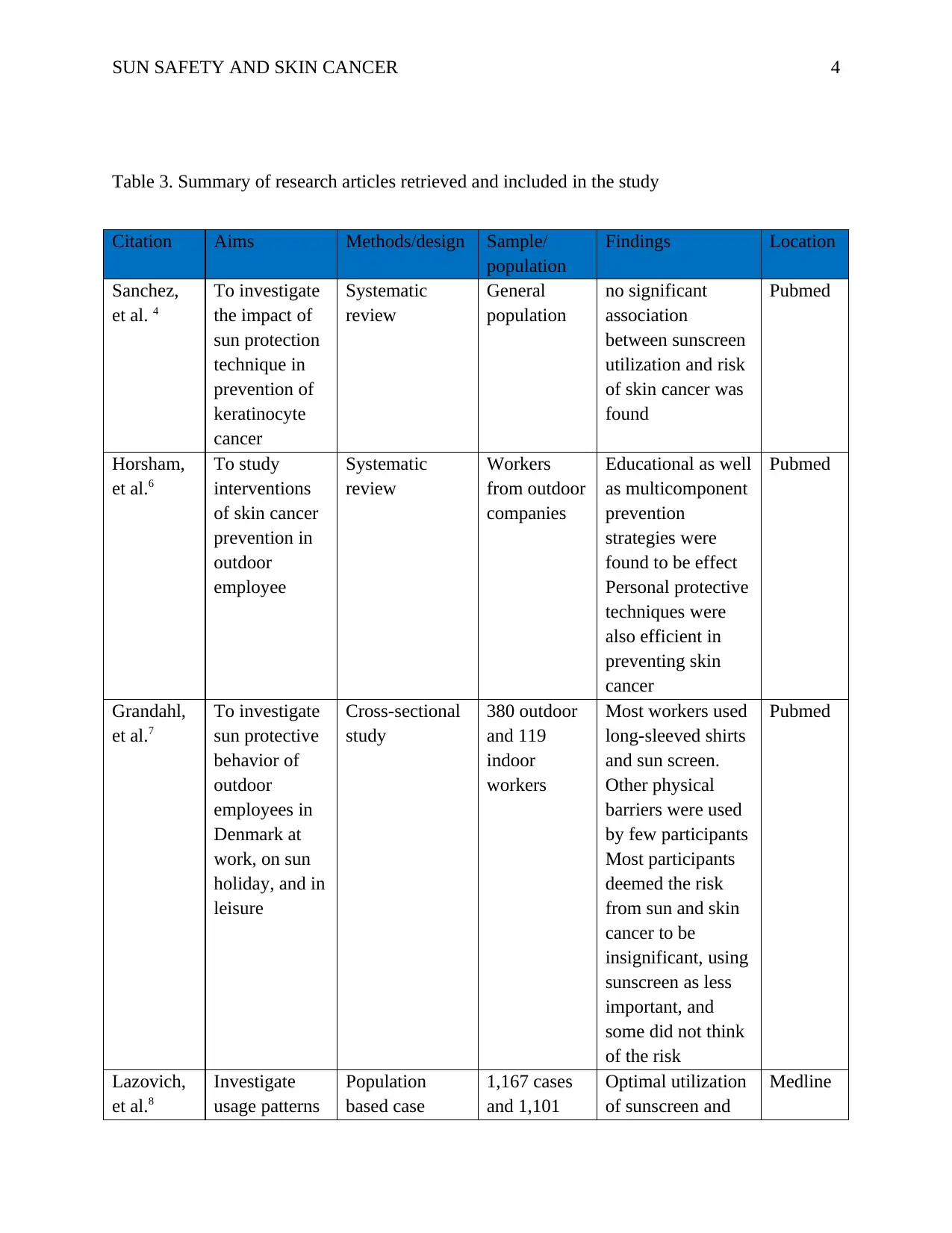
SUN SAFETY AND SKIN CANCER 4
Table 3. Summary of research articles retrieved and included in the study
Citation Aims Methods/design Sample/
population
Findings Location
Sanchez,
et al. 4
To investigate
the impact of
sun protection
technique in
prevention of
keratinocyte
cancer
Systematic
review
General
population
no significant
association
between sunscreen
utilization and risk
of skin cancer was
found
Pubmed
Horsham,
et al.6
To study
interventions
of skin cancer
prevention in
outdoor
employee
Systematic
review
Workers
from outdoor
companies
Educational as well
as multicomponent
prevention
strategies were
found to be effect
Personal protective
techniques were
also efficient in
preventing skin
cancer
Pubmed
Grandahl,
et al.7
To investigate
sun protective
behavior of
outdoor
employees in
Denmark at
work, on sun
holiday, and in
leisure
Cross-sectional
study
380 outdoor
and 119
indoor
workers
Most workers used
long-sleeved shirts
and sun screen.
Other physical
barriers were used
by few participants
Most participants
deemed the risk
from sun and skin
cancer to be
insignificant, using
sunscreen as less
important, and
some did not think
of the risk
Pubmed
Lazovich,
et al.8
Investigate
usage patterns
Population
based case
1,167 cases
and 1,101
Optimal utilization
of sunscreen and
Medline
Table 3. Summary of research articles retrieved and included in the study
Citation Aims Methods/design Sample/
population
Findings Location
Sanchez,
et al. 4
To investigate
the impact of
sun protection
technique in
prevention of
keratinocyte
cancer
Systematic
review
General
population
no significant
association
between sunscreen
utilization and risk
of skin cancer was
found
Pubmed
Horsham,
et al.6
To study
interventions
of skin cancer
prevention in
outdoor
employee
Systematic
review
Workers
from outdoor
companies
Educational as well
as multicomponent
prevention
strategies were
found to be effect
Personal protective
techniques were
also efficient in
preventing skin
cancer
Pubmed
Grandahl,
et al.7
To investigate
sun protective
behavior of
outdoor
employees in
Denmark at
work, on sun
holiday, and in
leisure
Cross-sectional
study
380 outdoor
and 119
indoor
workers
Most workers used
long-sleeved shirts
and sun screen.
Other physical
barriers were used
by few participants
Most participants
deemed the risk
from sun and skin
cancer to be
insignificant, using
sunscreen as less
important, and
some did not think
of the risk
Pubmed
Lazovich,
et al.8
Investigate
usage patterns
Population
based case
1,167 cases
and 1,101
Optimal utilization
of sunscreen and
Medline
Paraphrase This Document
Need a fresh take? Get an instant paraphrase of this document with our AI Paraphraser
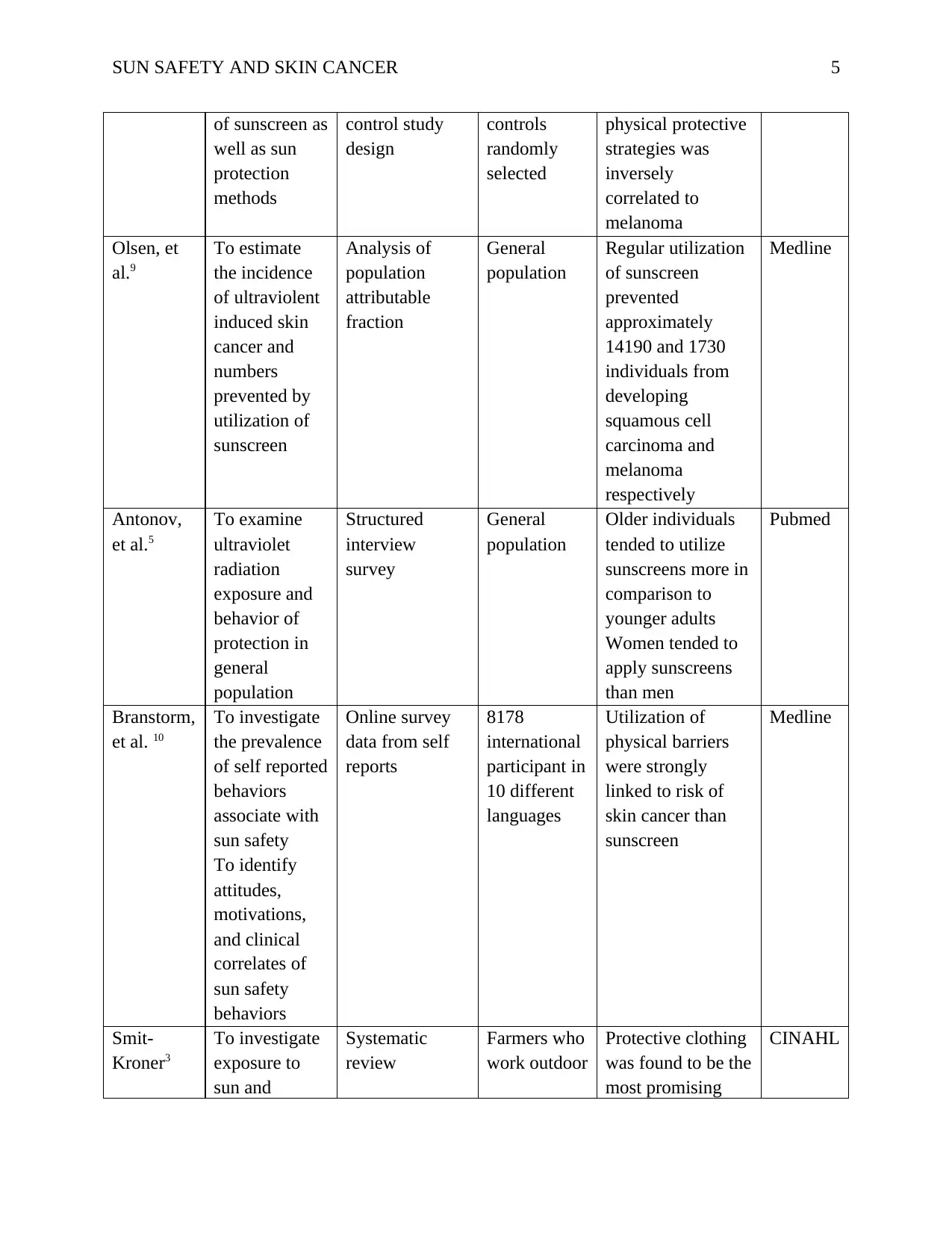
SUN SAFETY AND SKIN CANCER 5
of sunscreen as
well as sun
protection
methods
control study
design
controls
randomly
selected
physical protective
strategies was
inversely
correlated to
melanoma
Olsen, et
al.9
To estimate
the incidence
of ultraviolent
induced skin
cancer and
numbers
prevented by
utilization of
sunscreen
Analysis of
population
attributable
fraction
General
population
Regular utilization
of sunscreen
prevented
approximately
14190 and 1730
individuals from
developing
squamous cell
carcinoma and
melanoma
respectively
Medline
Antonov,
et al.5
To examine
ultraviolet
radiation
exposure and
behavior of
protection in
general
population
Structured
interview
survey
General
population
Older individuals
tended to utilize
sunscreens more in
comparison to
younger adults
Women tended to
apply sunscreens
than men
Pubmed
Branstorm,
et al. 10
To investigate
the prevalence
of self reported
behaviors
associate with
sun safety
To identify
attitudes,
motivations,
and clinical
correlates of
sun safety
behaviors
Online survey
data from self
reports
8178
international
participant in
10 different
languages
Utilization of
physical barriers
were strongly
linked to risk of
skin cancer than
sunscreen
Medline
Smit-
Kroner3
To investigate
exposure to
sun and
Systematic
review
Farmers who
work outdoor
Protective clothing
was found to be the
most promising
CINAHL
of sunscreen as
well as sun
protection
methods
control study
design
controls
randomly
selected
physical protective
strategies was
inversely
correlated to
melanoma
Olsen, et
al.9
To estimate
the incidence
of ultraviolent
induced skin
cancer and
numbers
prevented by
utilization of
sunscreen
Analysis of
population
attributable
fraction
General
population
Regular utilization
of sunscreen
prevented
approximately
14190 and 1730
individuals from
developing
squamous cell
carcinoma and
melanoma
respectively
Medline
Antonov,
et al.5
To examine
ultraviolet
radiation
exposure and
behavior of
protection in
general
population
Structured
interview
survey
General
population
Older individuals
tended to utilize
sunscreens more in
comparison to
younger adults
Women tended to
apply sunscreens
than men
Pubmed
Branstorm,
et al. 10
To investigate
the prevalence
of self reported
behaviors
associate with
sun safety
To identify
attitudes,
motivations,
and clinical
correlates of
sun safety
behaviors
Online survey
data from self
reports
8178
international
participant in
10 different
languages
Utilization of
physical barriers
were strongly
linked to risk of
skin cancer than
sunscreen
Medline
Smit-
Kroner3
To investigate
exposure to
sun and
Systematic
review
Farmers who
work outdoor
Protective clothing
was found to be the
most promising
CINAHL
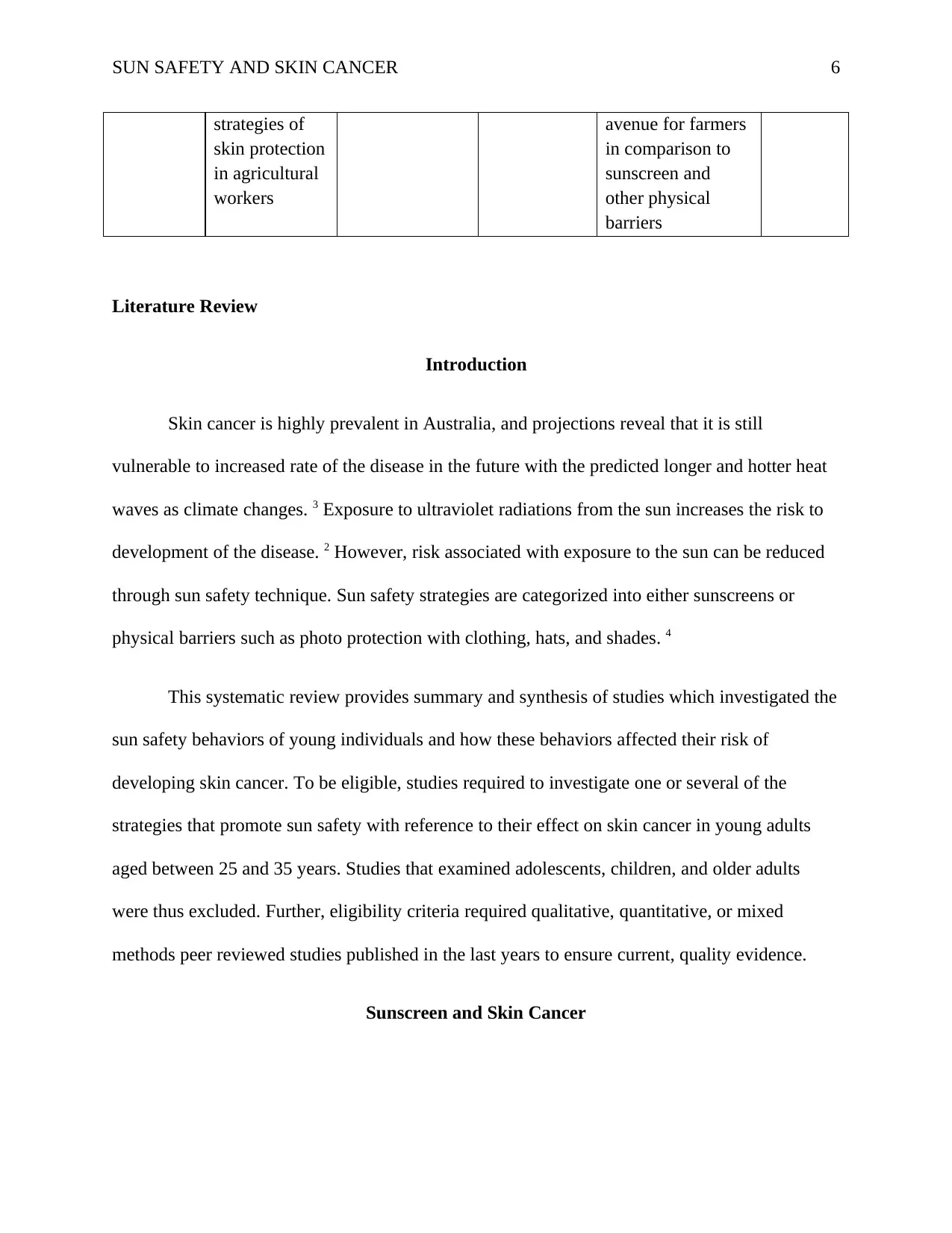
SUN SAFETY AND SKIN CANCER 6
strategies of
skin protection
in agricultural
workers
avenue for farmers
in comparison to
sunscreen and
other physical
barriers
Literature Review
Introduction
Skin cancer is highly prevalent in Australia, and projections reveal that it is still
vulnerable to increased rate of the disease in the future with the predicted longer and hotter heat
waves as climate changes. 3 Exposure to ultraviolet radiations from the sun increases the risk to
development of the disease. 2 However, risk associated with exposure to the sun can be reduced
through sun safety technique. Sun safety strategies are categorized into either sunscreens or
physical barriers such as photo protection with clothing, hats, and shades. 4
This systematic review provides summary and synthesis of studies which investigated the
sun safety behaviors of young individuals and how these behaviors affected their risk of
developing skin cancer. To be eligible, studies required to investigate one or several of the
strategies that promote sun safety with reference to their effect on skin cancer in young adults
aged between 25 and 35 years. Studies that examined adolescents, children, and older adults
were thus excluded. Further, eligibility criteria required qualitative, quantitative, or mixed
methods peer reviewed studies published in the last years to ensure current, quality evidence.
Sunscreen and Skin Cancer
strategies of
skin protection
in agricultural
workers
avenue for farmers
in comparison to
sunscreen and
other physical
barriers
Literature Review
Introduction
Skin cancer is highly prevalent in Australia, and projections reveal that it is still
vulnerable to increased rate of the disease in the future with the predicted longer and hotter heat
waves as climate changes. 3 Exposure to ultraviolet radiations from the sun increases the risk to
development of the disease. 2 However, risk associated with exposure to the sun can be reduced
through sun safety technique. Sun safety strategies are categorized into either sunscreens or
physical barriers such as photo protection with clothing, hats, and shades. 4
This systematic review provides summary and synthesis of studies which investigated the
sun safety behaviors of young individuals and how these behaviors affected their risk of
developing skin cancer. To be eligible, studies required to investigate one or several of the
strategies that promote sun safety with reference to their effect on skin cancer in young adults
aged between 25 and 35 years. Studies that examined adolescents, children, and older adults
were thus excluded. Further, eligibility criteria required qualitative, quantitative, or mixed
methods peer reviewed studies published in the last years to ensure current, quality evidence.
Sunscreen and Skin Cancer
⊘ This is a preview!⊘
Do you want full access?
Subscribe today to unlock all pages.

Trusted by 1+ million students worldwide
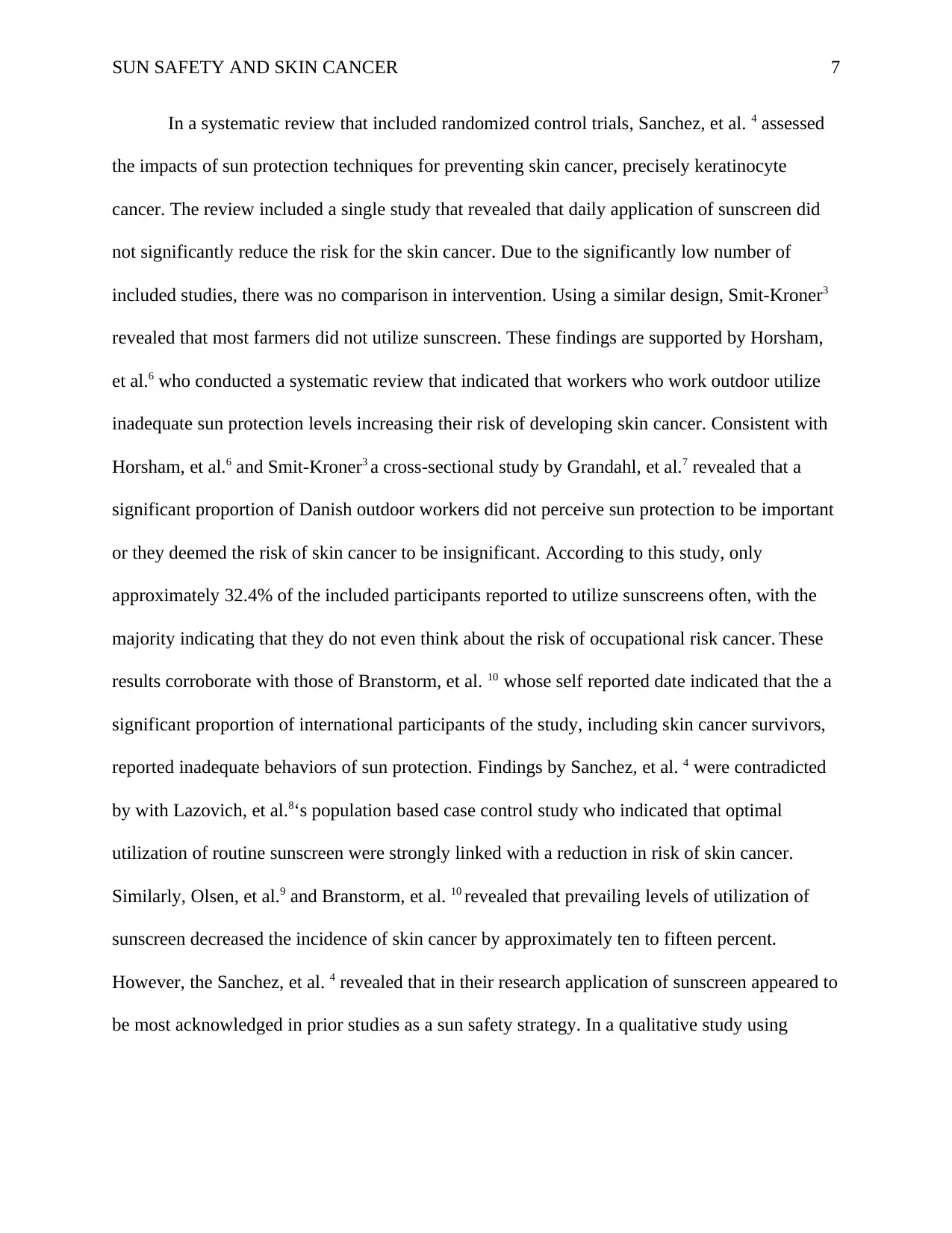
SUN SAFETY AND SKIN CANCER 7
In a systematic review that included randomized control trials, Sanchez, et al. 4 assessed
the impacts of sun protection techniques for preventing skin cancer, precisely keratinocyte
cancer. The review included a single study that revealed that daily application of sunscreen did
not significantly reduce the risk for the skin cancer. Due to the significantly low number of
included studies, there was no comparison in intervention. Using a similar design, Smit-Kroner3
revealed that most farmers did not utilize sunscreen. These findings are supported by Horsham,
et al.6 who conducted a systematic review that indicated that workers who work outdoor utilize
inadequate sun protection levels increasing their risk of developing skin cancer. Consistent with
Horsham, et al.6 and Smit-Kroner3 a cross-sectional study by Grandahl, et al.7 revealed that a
significant proportion of Danish outdoor workers did not perceive sun protection to be important
or they deemed the risk of skin cancer to be insignificant. According to this study, only
approximately 32.4% of the included participants reported to utilize sunscreens often, with the
majority indicating that they do not even think about the risk of occupational risk cancer. These
results corroborate with those of Branstorm, et al. 10 whose self reported date indicated that the a
significant proportion of international participants of the study, including skin cancer survivors,
reported inadequate behaviors of sun protection. Findings by Sanchez, et al. 4 were contradicted
by with Lazovich, et al.8‘s population based case control study who indicated that optimal
utilization of routine sunscreen were strongly linked with a reduction in risk of skin cancer.
Similarly, Olsen, et al.9 and Branstorm, et al. 10 revealed that prevailing levels of utilization of
sunscreen decreased the incidence of skin cancer by approximately ten to fifteen percent.
However, the Sanchez, et al. 4 revealed that in their research application of sunscreen appeared to
be most acknowledged in prior studies as a sun safety strategy. In a qualitative study using
In a systematic review that included randomized control trials, Sanchez, et al. 4 assessed
the impacts of sun protection techniques for preventing skin cancer, precisely keratinocyte
cancer. The review included a single study that revealed that daily application of sunscreen did
not significantly reduce the risk for the skin cancer. Due to the significantly low number of
included studies, there was no comparison in intervention. Using a similar design, Smit-Kroner3
revealed that most farmers did not utilize sunscreen. These findings are supported by Horsham,
et al.6 who conducted a systematic review that indicated that workers who work outdoor utilize
inadequate sun protection levels increasing their risk of developing skin cancer. Consistent with
Horsham, et al.6 and Smit-Kroner3 a cross-sectional study by Grandahl, et al.7 revealed that a
significant proportion of Danish outdoor workers did not perceive sun protection to be important
or they deemed the risk of skin cancer to be insignificant. According to this study, only
approximately 32.4% of the included participants reported to utilize sunscreens often, with the
majority indicating that they do not even think about the risk of occupational risk cancer. These
results corroborate with those of Branstorm, et al. 10 whose self reported date indicated that the a
significant proportion of international participants of the study, including skin cancer survivors,
reported inadequate behaviors of sun protection. Findings by Sanchez, et al. 4 were contradicted
by with Lazovich, et al.8‘s population based case control study who indicated that optimal
utilization of routine sunscreen were strongly linked with a reduction in risk of skin cancer.
Similarly, Olsen, et al.9 and Branstorm, et al. 10 revealed that prevailing levels of utilization of
sunscreen decreased the incidence of skin cancer by approximately ten to fifteen percent.
However, the Sanchez, et al. 4 revealed that in their research application of sunscreen appeared to
be most acknowledged in prior studies as a sun safety strategy. In a qualitative study using
Paraphrase This Document
Need a fresh take? Get an instant paraphrase of this document with our AI Paraphraser
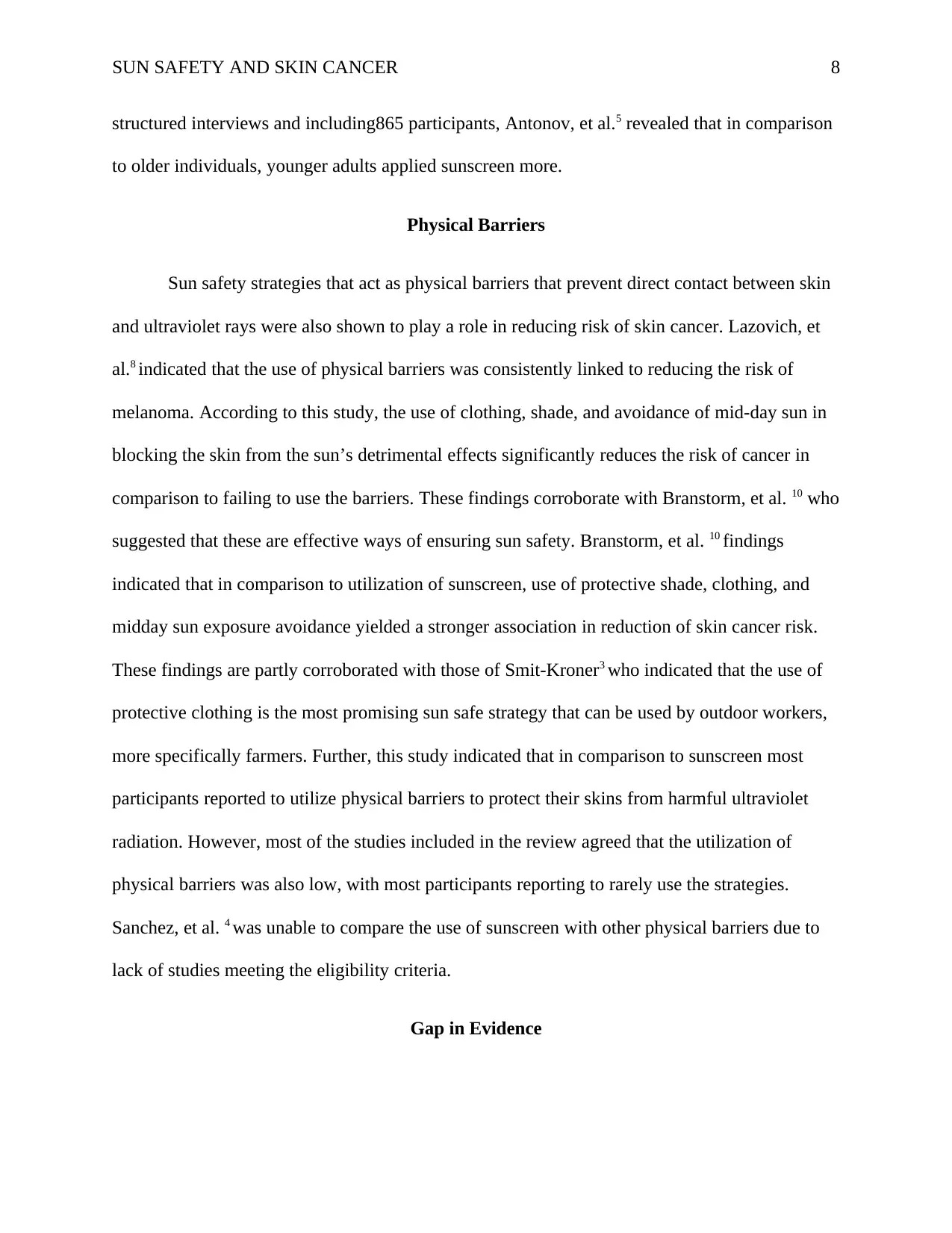
SUN SAFETY AND SKIN CANCER 8
structured interviews and including865 participants, Antonov, et al.5 revealed that in comparison
to older individuals, younger adults applied sunscreen more.
Physical Barriers
Sun safety strategies that act as physical barriers that prevent direct contact between skin
and ultraviolet rays were also shown to play a role in reducing risk of skin cancer. Lazovich, et
al.8 indicated that the use of physical barriers was consistently linked to reducing the risk of
melanoma. According to this study, the use of clothing, shade, and avoidance of mid-day sun in
blocking the skin from the sun’s detrimental effects significantly reduces the risk of cancer in
comparison to failing to use the barriers. These findings corroborate with Branstorm, et al. 10 who
suggested that these are effective ways of ensuring sun safety. Branstorm, et al. 10 findings
indicated that in comparison to utilization of sunscreen, use of protective shade, clothing, and
midday sun exposure avoidance yielded a stronger association in reduction of skin cancer risk.
These findings are partly corroborated with those of Smit-Kroner3 who indicated that the use of
protective clothing is the most promising sun safe strategy that can be used by outdoor workers,
more specifically farmers. Further, this study indicated that in comparison to sunscreen most
participants reported to utilize physical barriers to protect their skins from harmful ultraviolet
radiation. However, most of the studies included in the review agreed that the utilization of
physical barriers was also low, with most participants reporting to rarely use the strategies.
Sanchez, et al. 4 was unable to compare the use of sunscreen with other physical barriers due to
lack of studies meeting the eligibility criteria.
Gap in Evidence
structured interviews and including865 participants, Antonov, et al.5 revealed that in comparison
to older individuals, younger adults applied sunscreen more.
Physical Barriers
Sun safety strategies that act as physical barriers that prevent direct contact between skin
and ultraviolet rays were also shown to play a role in reducing risk of skin cancer. Lazovich, et
al.8 indicated that the use of physical barriers was consistently linked to reducing the risk of
melanoma. According to this study, the use of clothing, shade, and avoidance of mid-day sun in
blocking the skin from the sun’s detrimental effects significantly reduces the risk of cancer in
comparison to failing to use the barriers. These findings corroborate with Branstorm, et al. 10 who
suggested that these are effective ways of ensuring sun safety. Branstorm, et al. 10 findings
indicated that in comparison to utilization of sunscreen, use of protective shade, clothing, and
midday sun exposure avoidance yielded a stronger association in reduction of skin cancer risk.
These findings are partly corroborated with those of Smit-Kroner3 who indicated that the use of
protective clothing is the most promising sun safe strategy that can be used by outdoor workers,
more specifically farmers. Further, this study indicated that in comparison to sunscreen most
participants reported to utilize physical barriers to protect their skins from harmful ultraviolet
radiation. However, most of the studies included in the review agreed that the utilization of
physical barriers was also low, with most participants reporting to rarely use the strategies.
Sanchez, et al. 4 was unable to compare the use of sunscreen with other physical barriers due to
lack of studies meeting the eligibility criteria.
Gap in Evidence

SUN SAFETY AND SKIN CANCER 9
Most of the included studies investigated sun protection behaviors of different
populations with regard to the sun safe strategies preferred and utilized. Most of the studies
emphasized on the use of sunscreen in their investigation. One of the emerging issues is the lack
of adequate utilization of sun safe strategies, especially those who have elevated risk to cancer,
outdoor workers. Some retrieved studies attempted to suggest the probable reason for this
occurrence with the majority attributing it lack of knowledge and cancer-related information.6,7
Therefore, studies investigating the hindrance to adopting sun safe strategies in reducing the risk
of occupational skin cancer should be conducted. Secondly, the lack of studies utilizing
randomized control trials was evident to assess the effects of preventive strategies from
ultraviolet radiations on skin cancer. Studies should thus be conducted using randomized control
trials to ensure high quality evidence is documented to help in practice. Further, although most
studies emphasized on the use of sunscreen the lack of evidence on the efficacy of this strategy
in reducing risk of skin cancer is evident, with some strategies acknowledging this gap.9,4,8.
Clearly establishing the effectiveness of sunscreen may help increase utilization and thus
incidence of skin cancer.
Research Question
What is the efficacy of utilization of sunscreen in reducing skin cancer risk in comparison with
lack of utilization?
Quality Assessment of Quantitative Study
The quantitative study by Grandahl, et al.7 utilized a cross-sectional design, an
appropriate choice considering that the focus of the study was descriptive, to study sun safety
behaviors as a risk factor of skin cancer. Cross-sectional studies are appropriate when the aim is
Most of the included studies investigated sun protection behaviors of different
populations with regard to the sun safe strategies preferred and utilized. Most of the studies
emphasized on the use of sunscreen in their investigation. One of the emerging issues is the lack
of adequate utilization of sun safe strategies, especially those who have elevated risk to cancer,
outdoor workers. Some retrieved studies attempted to suggest the probable reason for this
occurrence with the majority attributing it lack of knowledge and cancer-related information.6,7
Therefore, studies investigating the hindrance to adopting sun safe strategies in reducing the risk
of occupational skin cancer should be conducted. Secondly, the lack of studies utilizing
randomized control trials was evident to assess the effects of preventive strategies from
ultraviolet radiations on skin cancer. Studies should thus be conducted using randomized control
trials to ensure high quality evidence is documented to help in practice. Further, although most
studies emphasized on the use of sunscreen the lack of evidence on the efficacy of this strategy
in reducing risk of skin cancer is evident, with some strategies acknowledging this gap.9,4,8.
Clearly establishing the effectiveness of sunscreen may help increase utilization and thus
incidence of skin cancer.
Research Question
What is the efficacy of utilization of sunscreen in reducing skin cancer risk in comparison with
lack of utilization?
Quality Assessment of Quantitative Study
The quantitative study by Grandahl, et al.7 utilized a cross-sectional design, an
appropriate choice considering that the focus of the study was descriptive, to study sun safety
behaviors as a risk factor of skin cancer. Cross-sectional studies are appropriate when the aim is
⊘ This is a preview!⊘
Do you want full access?
Subscribe today to unlock all pages.

Trusted by 1+ million students worldwide
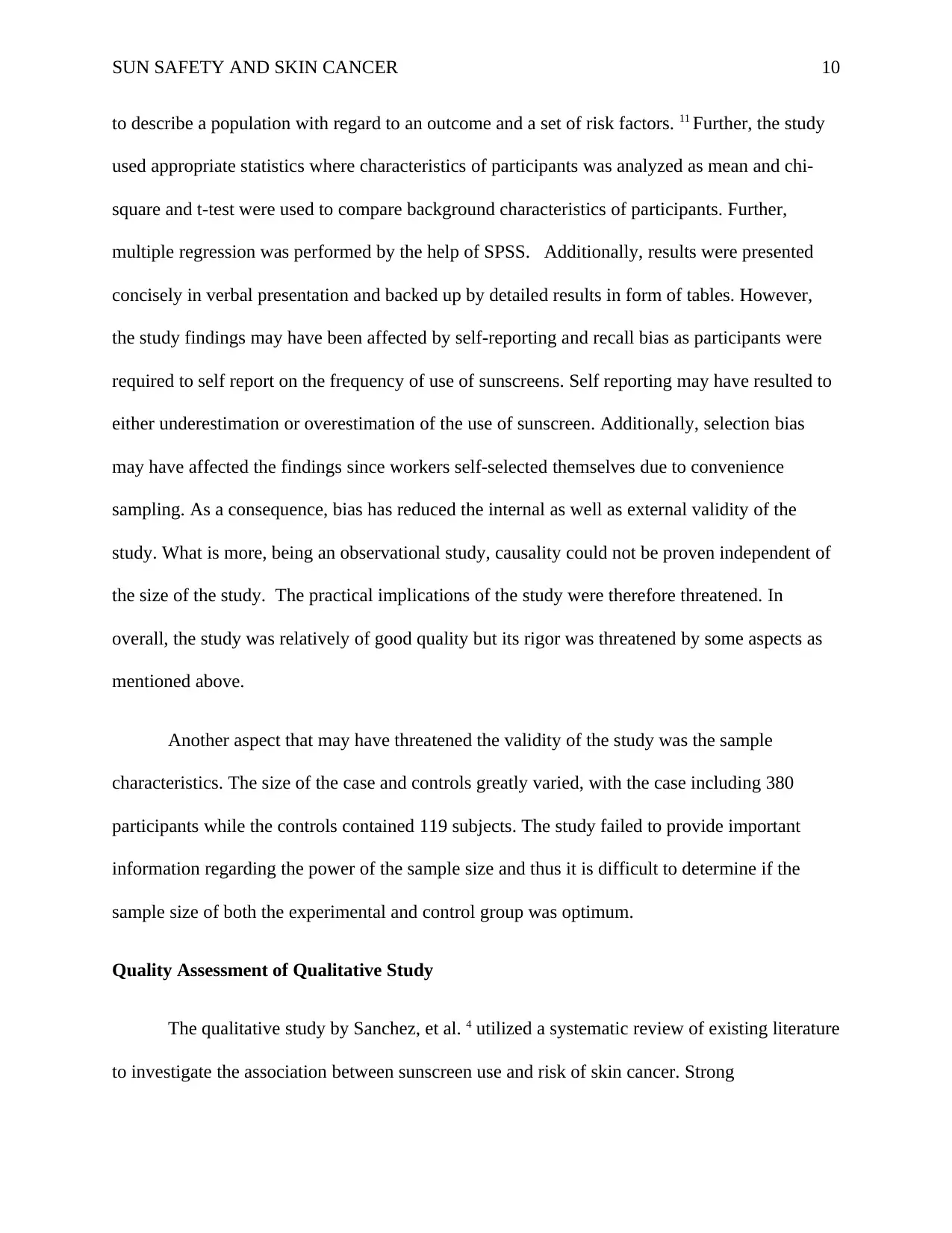
SUN SAFETY AND SKIN CANCER 10
to describe a population with regard to an outcome and a set of risk factors. 11 Further, the study
used appropriate statistics where characteristics of participants was analyzed as mean and chi-
square and t-test were used to compare background characteristics of participants. Further,
multiple regression was performed by the help of SPSS. Additionally, results were presented
concisely in verbal presentation and backed up by detailed results in form of tables. However,
the study findings may have been affected by self-reporting and recall bias as participants were
required to self report on the frequency of use of sunscreens. Self reporting may have resulted to
either underestimation or overestimation of the use of sunscreen. Additionally, selection bias
may have affected the findings since workers self-selected themselves due to convenience
sampling. As a consequence, bias has reduced the internal as well as external validity of the
study. What is more, being an observational study, causality could not be proven independent of
the size of the study. The practical implications of the study were therefore threatened. In
overall, the study was relatively of good quality but its rigor was threatened by some aspects as
mentioned above.
Another aspect that may have threatened the validity of the study was the sample
characteristics. The size of the case and controls greatly varied, with the case including 380
participants while the controls contained 119 subjects. The study failed to provide important
information regarding the power of the sample size and thus it is difficult to determine if the
sample size of both the experimental and control group was optimum.
Quality Assessment of Qualitative Study
The qualitative study by Sanchez, et al. 4 utilized a systematic review of existing literature
to investigate the association between sunscreen use and risk of skin cancer. Strong
to describe a population with regard to an outcome and a set of risk factors. 11 Further, the study
used appropriate statistics where characteristics of participants was analyzed as mean and chi-
square and t-test were used to compare background characteristics of participants. Further,
multiple regression was performed by the help of SPSS. Additionally, results were presented
concisely in verbal presentation and backed up by detailed results in form of tables. However,
the study findings may have been affected by self-reporting and recall bias as participants were
required to self report on the frequency of use of sunscreens. Self reporting may have resulted to
either underestimation or overestimation of the use of sunscreen. Additionally, selection bias
may have affected the findings since workers self-selected themselves due to convenience
sampling. As a consequence, bias has reduced the internal as well as external validity of the
study. What is more, being an observational study, causality could not be proven independent of
the size of the study. The practical implications of the study were therefore threatened. In
overall, the study was relatively of good quality but its rigor was threatened by some aspects as
mentioned above.
Another aspect that may have threatened the validity of the study was the sample
characteristics. The size of the case and controls greatly varied, with the case including 380
participants while the controls contained 119 subjects. The study failed to provide important
information regarding the power of the sample size and thus it is difficult to determine if the
sample size of both the experimental and control group was optimum.
Quality Assessment of Qualitative Study
The qualitative study by Sanchez, et al. 4 utilized a systematic review of existing literature
to investigate the association between sunscreen use and risk of skin cancer. Strong
Paraphrase This Document
Need a fresh take? Get an instant paraphrase of this document with our AI Paraphraser

SUN SAFETY AND SKIN CANCER 11
methodological strategies to systematic review enhance the consistency, transparency, as well as
scientific rigor of the studies. 13 The eligibility criteria required inclusion of randomized control
trials, an appropriate criteria considering that researches utilizing these designs are deemed to
contain high quality evidence. More precisely, randomized control trials are considered the
cornerstone of clinical research on interventions. 12 Moreover, systematic reviews of randomized
control trials present the highest level of evidence. 12 Thus, this improved the quality of the
systematic review. Further, the study clearly addressed a focused research question clearly
defining the population, intervention, and outcome. Further, the study appropriately assessed the
quality of the included study. More precisely, two of the researchers evaluated the risk of bias of
the randomized control trial. Also, since the study included a single study, presentation of the
results was not intricate and they were presented in form of table, and coupled with concise
explanation. Further, all outcomes were considered and outlined clearly. Although this study had
diverse strengths, a limitation arose from its limited ability to be generalized. This is because
only a single study met the inclusion criteria and thus practical implications were threatened.
Overall, this qualitative study was of high quality as it met most of the required criteria.
methodological strategies to systematic review enhance the consistency, transparency, as well as
scientific rigor of the studies. 13 The eligibility criteria required inclusion of randomized control
trials, an appropriate criteria considering that researches utilizing these designs are deemed to
contain high quality evidence. More precisely, randomized control trials are considered the
cornerstone of clinical research on interventions. 12 Moreover, systematic reviews of randomized
control trials present the highest level of evidence. 12 Thus, this improved the quality of the
systematic review. Further, the study clearly addressed a focused research question clearly
defining the population, intervention, and outcome. Further, the study appropriately assessed the
quality of the included study. More precisely, two of the researchers evaluated the risk of bias of
the randomized control trial. Also, since the study included a single study, presentation of the
results was not intricate and they were presented in form of table, and coupled with concise
explanation. Further, all outcomes were considered and outlined clearly. Although this study had
diverse strengths, a limitation arose from its limited ability to be generalized. This is because
only a single study met the inclusion criteria and thus practical implications were threatened.
Overall, this qualitative study was of high quality as it met most of the required criteria.
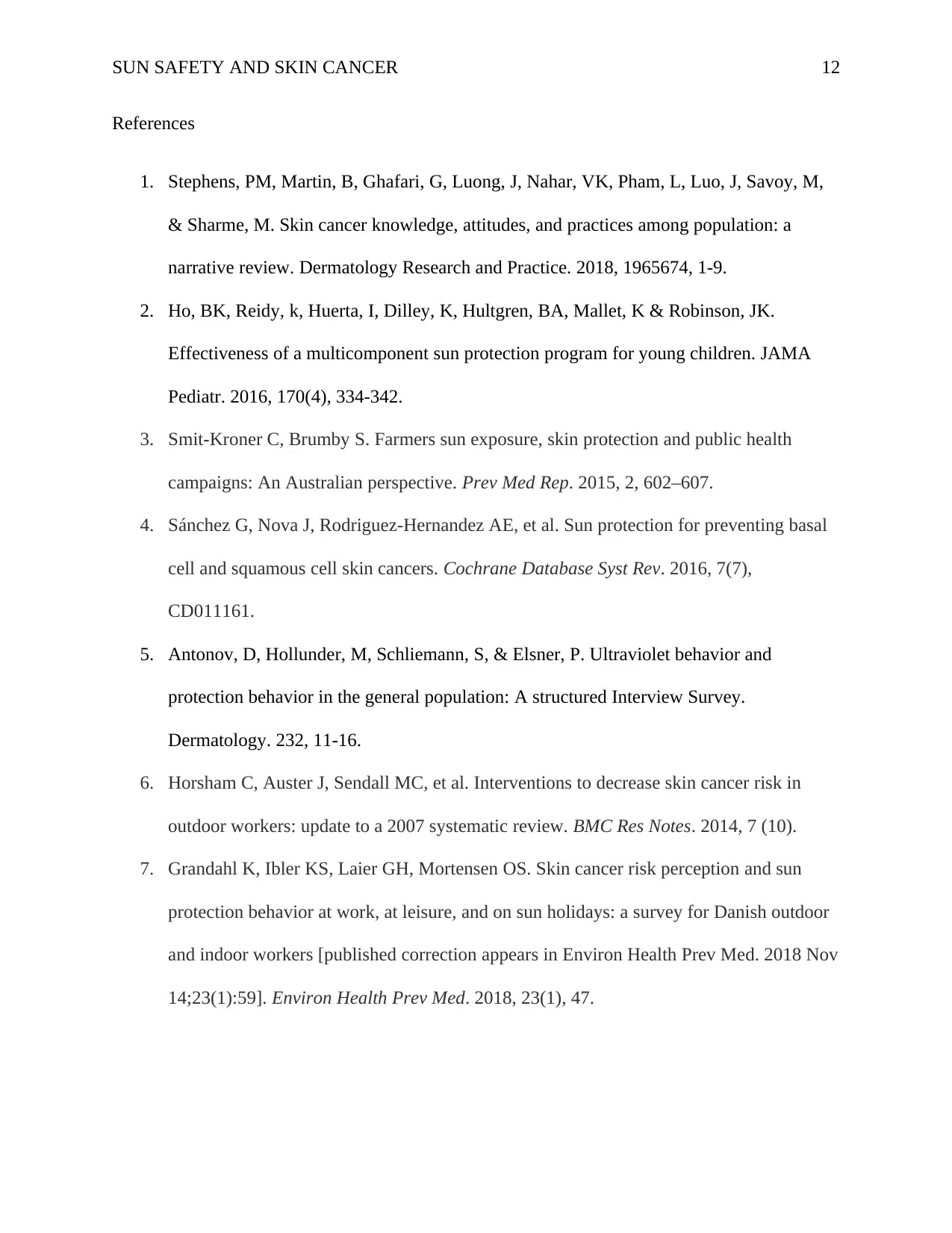
SUN SAFETY AND SKIN CANCER 12
References
1. Stephens, PM, Martin, B, Ghafari, G, Luong, J, Nahar, VK, Pham, L, Luo, J, Savoy, M,
& Sharme, M. Skin cancer knowledge, attitudes, and practices among population: a
narrative review. Dermatology Research and Practice. 2018, 1965674, 1-9.
2. Ho, BK, Reidy, k, Huerta, I, Dilley, K, Hultgren, BA, Mallet, K & Robinson, JK.
Effectiveness of a multicomponent sun protection program for young children. JAMA
Pediatr. 2016, 170(4), 334-342.
3. Smit-Kroner C, Brumby S. Farmers sun exposure, skin protection and public health
campaigns: An Australian perspective. Prev Med Rep. 2015, 2, 602–607.
4. Sánchez G, Nova J, Rodriguez-Hernandez AE, et al. Sun protection for preventing basal
cell and squamous cell skin cancers. Cochrane Database Syst Rev. 2016, 7(7),
CD011161.
5. Antonov, D, Hollunder, M, Schliemann, S, & Elsner, P. Ultraviolet behavior and
protection behavior in the general population: A structured Interview Survey.
Dermatology. 232, 11-16.
6. Horsham C, Auster J, Sendall MC, et al. Interventions to decrease skin cancer risk in
outdoor workers: update to a 2007 systematic review. BMC Res Notes. 2014, 7 (10).
7. Grandahl K, Ibler KS, Laier GH, Mortensen OS. Skin cancer risk perception and sun
protection behavior at work, at leisure, and on sun holidays: a survey for Danish outdoor
and indoor workers [published correction appears in Environ Health Prev Med. 2018 Nov
14;23(1):59]. Environ Health Prev Med. 2018, 23(1), 47.
References
1. Stephens, PM, Martin, B, Ghafari, G, Luong, J, Nahar, VK, Pham, L, Luo, J, Savoy, M,
& Sharme, M. Skin cancer knowledge, attitudes, and practices among population: a
narrative review. Dermatology Research and Practice. 2018, 1965674, 1-9.
2. Ho, BK, Reidy, k, Huerta, I, Dilley, K, Hultgren, BA, Mallet, K & Robinson, JK.
Effectiveness of a multicomponent sun protection program for young children. JAMA
Pediatr. 2016, 170(4), 334-342.
3. Smit-Kroner C, Brumby S. Farmers sun exposure, skin protection and public health
campaigns: An Australian perspective. Prev Med Rep. 2015, 2, 602–607.
4. Sánchez G, Nova J, Rodriguez-Hernandez AE, et al. Sun protection for preventing basal
cell and squamous cell skin cancers. Cochrane Database Syst Rev. 2016, 7(7),
CD011161.
5. Antonov, D, Hollunder, M, Schliemann, S, & Elsner, P. Ultraviolet behavior and
protection behavior in the general population: A structured Interview Survey.
Dermatology. 232, 11-16.
6. Horsham C, Auster J, Sendall MC, et al. Interventions to decrease skin cancer risk in
outdoor workers: update to a 2007 systematic review. BMC Res Notes. 2014, 7 (10).
7. Grandahl K, Ibler KS, Laier GH, Mortensen OS. Skin cancer risk perception and sun
protection behavior at work, at leisure, and on sun holidays: a survey for Danish outdoor
and indoor workers [published correction appears in Environ Health Prev Med. 2018 Nov
14;23(1):59]. Environ Health Prev Med. 2018, 23(1), 47.
⊘ This is a preview!⊘
Do you want full access?
Subscribe today to unlock all pages.

Trusted by 1+ million students worldwide
1 out of 13
Your All-in-One AI-Powered Toolkit for Academic Success.
+13062052269
info@desklib.com
Available 24*7 on WhatsApp / Email
![[object Object]](/_next/static/media/star-bottom.7253800d.svg)
Unlock your academic potential
Copyright © 2020–2026 A2Z Services. All Rights Reserved. Developed and managed by ZUCOL.

